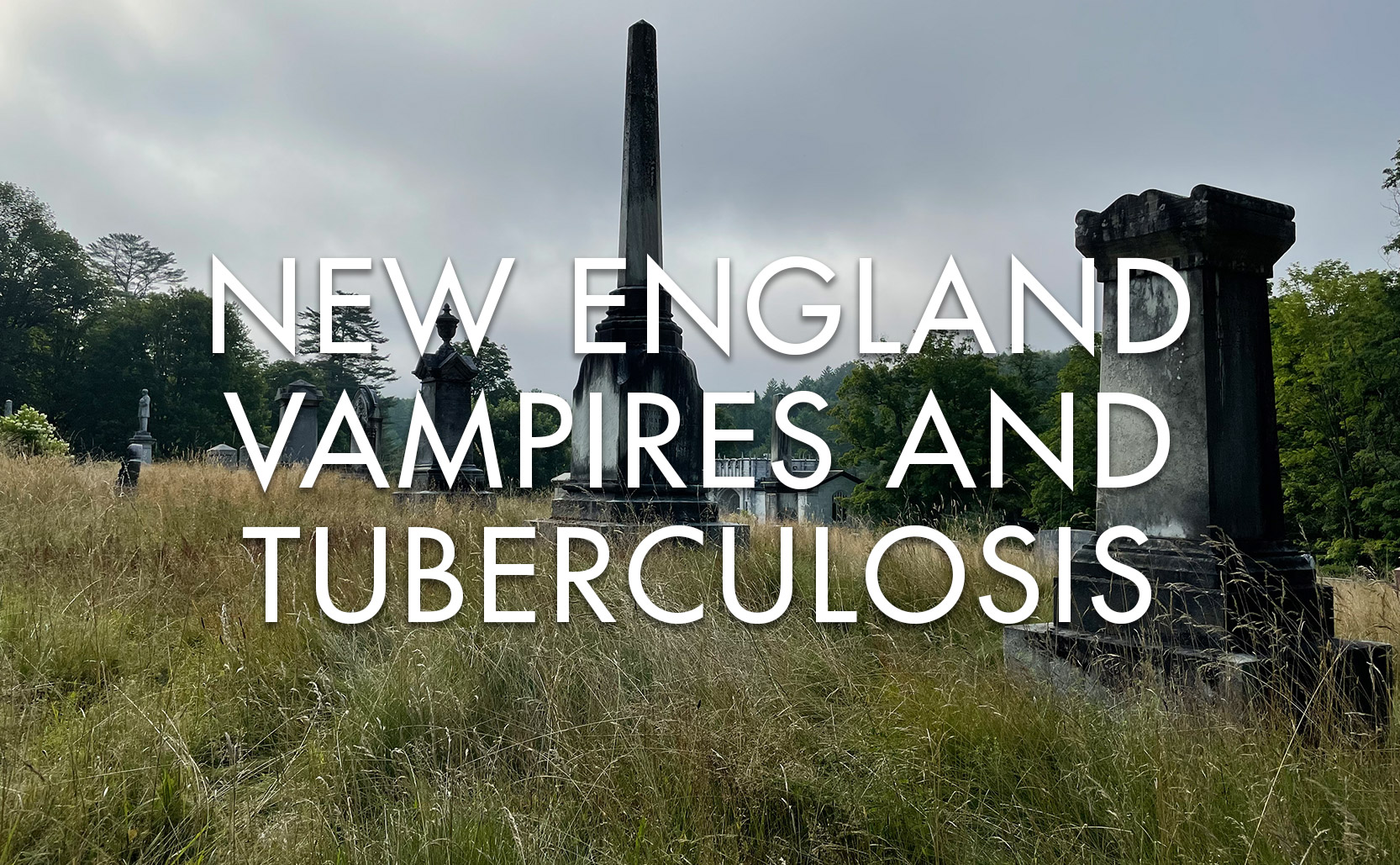The effects of tuberculosis led some 19th century New Englanders to believe that vampires were preying on the living.
In the late 18th and much of the 19th century there was a vampire panic in New England. People across New England feared that vampire-like creatures, using some kind of sympathetic magic, were slowly killing their friends & family from inside the grave (as opposed to traditional vampires who rise from the grave to attack). People would exhume their family members, look for the one who might be a vampire, and take various precautions to stop them. New Englanders might remove & burn the heart of a suspected vampire, they may turn the skeleton over facedown, decapitate the head, put a brick in their mouth, or use a wooden stake to pin their relative to the ground among other methods.
This panic was more than just a few isolated incidents. Henry David Thoreau mentions attending an exhumation in his journal on September 26, 1859. In February of 1793 over 500 people attended the ceremonial burning of the heart, liver, and lungs of supposed vampire Rachel Harris in Manchester, Vermont. After Nancy Young died in 1827 Rhode Island, her father thought that she might be preying on her still alive little sister Almira. The family exhumed Nancy’s coffin, burned it on a pyre, and stood in the smoke to breath in the vapors thinking it would free/cure them of this affliction – it did not work and Almira and two more of her siblings later died. Digesting the cremated remains of a suspected vampire, or breathing in the smoke of the cremation pyre, were not uncommon last resort treatments after traditional medicine had failed.
The 1892 exhuming of suspected vampire Mercy Brown in Exeter, Rhode Island became an international story – Bram Stoker based part of the Lucy character in Dracula on Mercy Brown. With 18 confirmed vampire cases, Rhode Island even become known as the “Vampire Capital of America.” The reason all of this happened was twofold: tuberculosis and decomposition.

Wasting away
Tuberculosis is an airborne disease that attacks the lungs (among other areas). Active tuberculosis kills about half of those infected and in 2018 it was the ninth leading cause of death worldwide (killing more people than Malaria or HIV/AIDS). In 19th century New England tuberculosis was the leading cause of death, killing an estimated 25% of the population.
Tuberculosis can develop over months or even years, slowly eating away at someone. A person with active TB develops a chronic cough as their lung tissue breaks down, their mucus starts to contain blood, they develop fevers, night sweats, and lose weight. Because of the weight loss the disease has been historically known as “consumption.” As the infected person wastes away they also develop ashen skin, giving them an overall sickly drained appearance.
Vampires, or, a lack of scientific understanding
The effect of tuberculosis (the slow draining of life) combined with some of the infected saying their deceased relatives were visiting them (as Almira Young claimed), was enough for some New Englanders to suspect there were vampires at work. Bodies of suspected vampires were exhumed to looks for signs of vampirism. Some of the corpses seemed have grown longer finger nails and longer hair, some were bloated, some had blood in their organs, while others seemed to have not decayed at all. These were surefire signs of a vampire … or were just normal aspects of body decomposition.
As bodies decay they become dehydrated causing the skin to recede and shrink. This gives the illusion of longer fingernails & hair as the base of the nails and hair that was once under the skin is now exposed. The bodies that seemed to have not decayed at all were the ones of people who died in the cold winters of New England (as was Mercy Brown’s case who had died in January) where the cold slows the decomposition process. These unremarkable signs of decomposition were mistaken as proof of life after death to the untrained eyes of 19th century New England.
The dawn of a new era
The Mercy Brown story brought unwanted attention to New England. It was embarrassing that, while the light bulb was being invented and Henry Ford was building his first car, people were worried about folklorish undead monsters. The vampire panic rose and fell with the tuberculosis endemic of New England. Over time with advancements in science, and the dissemination of knowledge, belief in vampires faded away.
Added info: porphyria is another disease whose symptoms can be similar to vampire activity. It’s a liver disease that, for some, can cause sensitivity to sunlight (leading some to only come out at night) as well as sensitivity to garlic.





